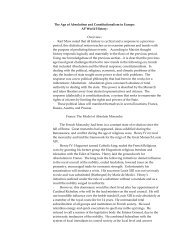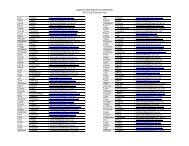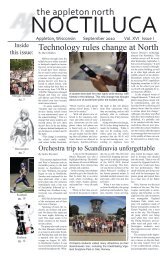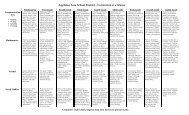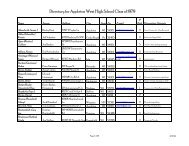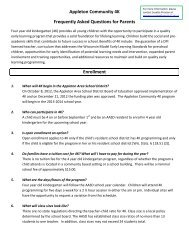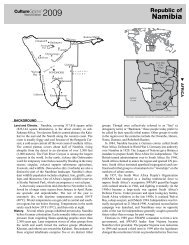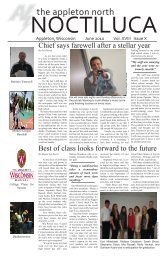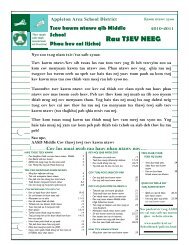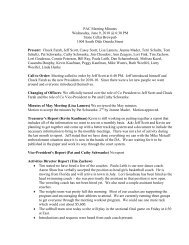Elementary Nutrition Guide for Appleton Area School District
Elementary Nutrition Guide for Appleton Area School District
Elementary Nutrition Guide for Appleton Area School District
Create successful ePaper yourself
Turn your PDF publications into a flip-book with our unique Google optimized e-Paper software.
Beyond the Stereotypes<br />
Facts About <strong>School</strong> Lunches<br />
ELEMENTARY NUTRITION GUIDE<br />
The reality of school nutrition programs is too often ignored in favor of a ratings boost based on<br />
stereotypes and biased in<strong>for</strong>mation. <strong>School</strong> lunches today follow federal nutrition guidelines and serve<br />
more fresh fruits and vegetables, whole grains, and low-fat dairy than ever be<strong>for</strong>e. On a very tight<br />
budget, school nutrition professionals are preparing and serving balanced, nutritious meals in an ageappropriate<br />
portion size that provides needed nutrients and promotes a healthy childhood weight.<br />
Myth Number One—<strong>School</strong> meals make children obese.<br />
Fact: Students who eat meals served through the National <strong>School</strong> Lunch Program are more likely to be at<br />
a healthy weight. Research published in the August 2003 issue of Archives of Pediatric and Adolescent<br />
Medicine concluded that “girls in food insecure households had significantly reduced odds of being at<br />
risk of overweight if they participated in the [National <strong>School</strong> Lunch, <strong>School</strong> Breakfast and Food Stamp<br />
Programs].” The research highlights the importance of food assistance programs to low-income children<br />
not only in addressing hunger “but also in potentially protecting them from excess weight gain." i] NSLP<br />
participants are more likely than non-participants to consume vegetables, milk and milk products, and<br />
meat and other protein-rich foods, both at lunch and over 24 hours; they also consume less soda and/or<br />
fruit drinks. [ii]<br />
Myth Number Two—<strong>School</strong>s serve junk food <strong>for</strong> school lunch.<br />
Fact: Meals served under the National <strong>School</strong> Lunch Program must, by federal law, meet <strong>Nutrition</strong><br />
guidelines based on the Dietary <strong>Guide</strong>lines <strong>for</strong> Americans. No more than 30 percent of calories can<br />
come from fat and less than 10 percent from saturated fat. <strong>School</strong> lunches provide one-third of the<br />
Recommended Dietary Allowances of protein, Vitamin A, Vitamin C, iron, calcium, and calories. These<br />
guidelines apply over the course of one week of school lunch menus. The 2001 <strong>School</strong> <strong>Nutrition</strong> and<br />
Dietary Assessment II (SNDA II) study based on research by the U.S. Department of Agriculture during<br />
the 1998–1999 school year found that students in 91 percent of secondary schools and 82 percent of<br />
elementary schools had the opportunity to select lunches that were consistent with dietary standards <strong>for</strong><br />
fat and saturated fat. [iii] National <strong>School</strong> Lunch Program participation is associated with higher average<br />
intakes of many nutrients, both at lunch and over 24 hours. NSLP participants have substantially lower<br />
intakes of added sugars than do non-participants. [ii]<br />
Myth Number Three—<strong>School</strong>s don’t serve enough fruits or vegetables <strong>for</strong> lunch.<br />
Fact: According to the <strong>School</strong> <strong>Nutrition</strong> Dietary Assessment II, approximately two-thirds of all school lunch<br />
menus offer more than the required two fruit and vegetable choices set by USDA regulations. [iii] The 2005<br />
<strong>School</strong> Foodservice and <strong>Nutrition</strong> Operations Survey Report conducted by SNA found that fresh fruits and<br />
vegetables are offered daily in 85 percent of high schools. [iv]<br />
Furthermore, salad bars are offered on a daily basis in over half of districts (at least one school per<br />
district) in the country [iv] . Vegetarian options are served in more than 30 percent of middle schools and<br />
high schools around the country, according to the 2005 SNA Operations Survey Report.<br />
6



